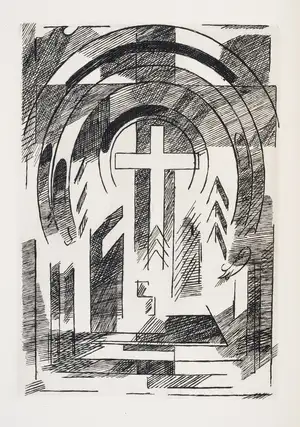Lot 212
Maurits Cornelis Escher (1898-1972)
Other World (Bool 348)
Hammer Price: £26,000
Description
Maurits Cornelis Escher (1898-1972)
Other World (Bool 348)
Wood engraving and woodcut printed in black, reddish brown and green, 1947, a fine impression the colours fresh, signed and inscribed 'eigen druck' in pencil, printed by the artist, on tissue-thin Japan paper, with full margins, sheet 395 x 324mm (15 1/2 x 12 3/4in)
Provenance: Acquired directly from the artist;
thence by descent.
Lot Essay:
In Other World, we finds ourselves “in a strange room in which up, down, left, right, front and back can be substituted arbitrarily, depending on whether we wish to look out through one window or another” (J. L. Locher, Escher: The Complete Graphic Work, p. 144).
Each side of the small room offers a view that is possible, but by linking the three different perspectives together – zenith, nadir and distance point – he has created an overall picture that is impossible. When discussing the print in a 1947 interview for the monthly periodical Phoenix, Escher explains how the print explores the possibility of viewing your surroundings like a bird. That is, the viewer may simultaneously explore from every conceivable vantage point. Each vantage point is conjured up by a window adorned with a suspended horn and the Simurgh: a mythical bird-like creature from ancient Persian art and literature.
The artist owes the inspiration for the Simurgh to his father-in-law, who gave him a statuette of this enigmatic creature as a wedding gift in 1924. Like the Phoenix in Christian symbolism, it represents the eternal spirit of life, death and rebirth. Both its form and the themes it represented fascinated Escher and it features in several of his prints, such as Still Life with Spherical Mirror.
Other World is one of a series of prints in which Escher toys with multiple perspectives. A few months before Escher set to work on Other World, he made the mezzotint Gallery. In January 1950, Escher wrote to his close friend, the engineer and art collector Paul Kessler: “Gallery dated XII-’46 drove me to despair; I finally completed it in April 1949. Other World is a follow-up to this, and the elongated lithograph Up and Down follows on from this one.” Other World is perhaps the most successful of the three, enticing the viewer’s eye to pore over this enchanting and mystifying moonscape ad infinitum.
Description
Maurits Cornelis Escher (1898-1972)
Other World (Bool 348)
Wood engraving and woodcut printed in black, reddish brown and green, 1947, a fine impression the colours fresh, signed and inscribed 'eigen druck' in pencil, printed by the artist, on tissue-thin Japan paper, with full margins, sheet 395 x 324mm (15 1/2 x 12 3/4in)
Provenance: Acquired directly from the artist;
thence by descent.
Lot Essay:
In Other World, we finds ourselves “in a strange room in which up, down, left, right, front and back can be substituted arbitrarily, depending on whether we wish to look out through one window or another” (J. L. Locher, Escher: The Complete Graphic Work, p. 144).
Each side of the small room offers a view that is possible, but by linking the three different perspectives together – zenith, nadir and distance point – he has created an overall picture that is impossible. When discussing the print in a 1947 interview for the monthly periodical Phoenix, Escher explains how the print explores the possibility of viewing your surroundings like a bird. That is, the viewer may simultaneously explore from every conceivable vantage point. Each vantage point is conjured up by a window adorned with a suspended horn and the Simurgh: a mythical bird-like creature from ancient Persian art and literature.
The artist owes the inspiration for the Simurgh to his father-in-law, who gave him a statuette of this enigmatic creature as a wedding gift in 1924. Like the Phoenix in Christian symbolism, it represents the eternal spirit of life, death and rebirth. Both its form and the themes it represented fascinated Escher and it features in several of his prints, such as Still Life with Spherical Mirror.
Other World is one of a series of prints in which Escher toys with multiple perspectives. A few months before Escher set to work on Other World, he made the mezzotint Gallery. In January 1950, Escher wrote to his close friend, the engineer and art collector Paul Kessler: “Gallery dated XII-’46 drove me to despair; I finally completed it in April 1949. Other World is a follow-up to this, and the elongated lithograph Up and Down follows on from this one.” Other World is perhaps the most successful of the three, enticing the viewer’s eye to pore over this enchanting and mystifying moonscape ad infinitum.







